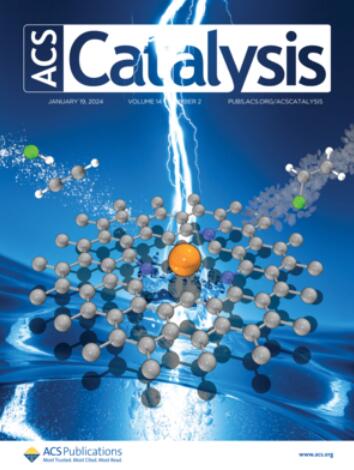在锌促进的钌基催化剂上,原位选择性位点阻断决定了苯部分加氢成环己烯
IF 11.3
1区 化学
Q1 CHEMISTRY, PHYSICAL
引用次数: 0
摘要
苯部分加氢制环己烯(CHE)是催化领域一个长期存在的难题。虽然锌促进的钌基催化剂在几十年前就获得了专利,达到了50%的CHE产率的最高记录,但经过40年的研究,苯中的不饱和C-C键比CHE中的不饱和C-C键更有选择性的活性位点和机制起源仍然没有解决。在这里,我们采用大规模机器学习驱动的全局优化方法,探索了数百万种Ru和Ru - zn候选结构,并在实际反应条件下,即50 atm H2压力下,在Zn2+水溶液中建立了完整的苯加氢反应网络。我们发现(i) Zn2+离子选择性沉积在波纹状Ru表面,例如Ru(101°0)和(101°1),它们通过阻断太活跃的位点来抑制深度氢化;(ii)部分氢化只发生在紧密堆积的Ru(0001)梯田上,上面覆盖着一层化学吸附的氢原子。微动力学模拟进一步证实,锌的存在通过毒害Ru纳米颗粒的波纹表面,使CHE产率从0%提高到50%。基于这些原子的见解,我们提出在Ru晶格中引入2%的拉伸应变可以将CHE收率提高到60%,CHE选择性为100%,突出了定制催化剂支撑的潜力,以最大化性能。本文章由计算机程序翻译,如有差异,请以英文原文为准。

In Situ Selective Site-Blocking Dictates Benzene Partial Hydrogenation to Cyclohexene on Zn-Promoted Ru-Based Catalysts
The partial hydrogenation of benzene to cyclohexene (CHE) represents a long-standing challenge in catalysis. Although Zn-promoted Ru-based catalysts were patented decades ago for achieving a top record of 50% CHE yield, the active sites and mechanistic origins of selectivity, specifically why the unsaturated C–C bonds in benzene are targeted over those in CHE, have remained unresolved despite four decades of research. Here, we employ large-scale machine-learning-driven global optimization to explore millions of Ru and Ru–Zn structure candidates and a complete benzene hydrogenation reaction network under realistic reaction conditions, that is, 50 atm H2 pressures, aqueous Zn2+ solution. We reveal that (i) Zn2+ ions selectively deposit on corrugated Ru surfaces, for example, Ru(101̅0) and (101̅1), where they inhibit deep hydrogenation by blocking too active sites; (ii) partial hydrogenation occurs exclusively on close-packed Ru(0001) terraces covered with one monolayer of chemisorbed H atoms. Microkinetics simulation further confirms that the presence of Zn enhances the CHE yield from 0% to 50% by poisoning corrugated surfaces in Ru nanoparticles. Building on these atomistic insights, we propose that introducing tensile strain 2% into the Ru lattice can elevate the CHE yield to 60% with 100% CHE selectivity, highlighting the potential for tailored catalyst supports to maximize performance.
求助全文
通过发布文献求助,成功后即可免费获取论文全文。
去求助
来源期刊

ACS Catalysis
CHEMISTRY, PHYSICAL-
CiteScore
20.80
自引率
6.20%
发文量
1253
审稿时长
1.5 months
期刊介绍:
ACS Catalysis is an esteemed journal that publishes original research in the fields of heterogeneous catalysis, molecular catalysis, and biocatalysis. It offers broad coverage across diverse areas such as life sciences, organometallics and synthesis, photochemistry and electrochemistry, drug discovery and synthesis, materials science, environmental protection, polymer discovery and synthesis, and energy and fuels.
The scope of the journal is to showcase innovative work in various aspects of catalysis. This includes new reactions and novel synthetic approaches utilizing known catalysts, the discovery or modification of new catalysts, elucidation of catalytic mechanisms through cutting-edge investigations, practical enhancements of existing processes, as well as conceptual advances in the field. Contributions to ACS Catalysis can encompass both experimental and theoretical research focused on catalytic molecules, macromolecules, and materials that exhibit catalytic turnover.
 求助内容:
求助内容: 应助结果提醒方式:
应助结果提醒方式:


